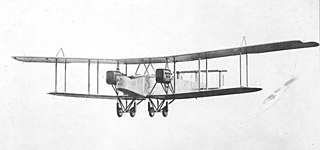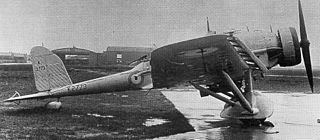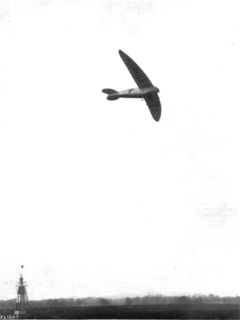
The Handley Page Type O was a biplane bomber used by Britain during the First World War. When built, the Type O was the largest aircraft that had been built in the UK and one of the largest in the world. There were two main variants, the Handley Page O/100 (H.P.11) and the Handley Page O/400 (H.P.12).

The Morane-Borel monoplane was an early French single-engine, single-seat aircraft. It was flown in several European air races.

The Bristol Gordon England biplanes were a series of early British military biplane aircraft designed by Gordon England for the Bristol Aeroplane Company that first flew in 1912. Designed for easy ground transport, the aircraft could be quickly disassembled.

The Blackburn Type D, sometimes known as the Single Seat Monoplane, was built by Robert Blackburn at Leeds in 1912. It is a single-engine mid-wing monoplane. Restored shortly after the Second World War, it remains part of the Shuttleworth Collection and is the oldest British flying aeroplane.

The Gloster TC.33 was a large four-engined biplane designed for troop carrying and medical evacuation in the early 1930s. Only one was built.

The Vickers Type 253 was a single-engined two-seat biplane general-purpose military machine built to a 1930 government specification. It won a production contract, but this was transferred to the same company's monoplane equivalent, the Wellesley. Only one Type 253 was built.

The Handley Page Type G was a two-seat British biplane, designed by Handley Page that first flew in 1913. Only one was built.
The Handley Page Type A, sometimes called "Bluebird" and later designated HP.1, was the first powered aircraft designed and built by Frederick Handley Page.
The Handley Page H.P.22 and H.P.23 were single-seat sport monoplanes produced for the 1923 Lympne light aircraft trials. They were not successful.

The Handley Page H.P.43 was a three-engined biplane bomber-transport built to an Air Ministry specification. It did not fly well and the biplane configuration was out-dated at completion; the only one constructed was later turned into a monoplane and led to the Handley Page H.P.54 Harrow.
The Handley Page H.P.51 was a monoplane conversion of the earlier, unsuccessful biplane bomber-transport aircraft, the Handley Page H.P.43. The Air Ministry ordered the production variant off the drawing board as the Handley Page H.P.54 Harrow bomber.

The Handley Page H.P.47 was a British single-engined low-wing monoplane built to an Air Ministry specification for a general-purpose bomber and torpedo bomber aircraft. Only one was built.

The Handley Page H.P.31 was a two-seat single-engined biplane built to a British specification for a carrier-based torpedo bomber and reconnaissance aircraft. After trials, the Blackburn Ripon was preferred, though the Harrow played a significant role in the development of automatic slots.

The Handley Page Type E was a two-seat, single-engined monoplane intended as a demonstrator. Though only one was built, it flew successfully from 1912 to 1914, carrying several hundred passengers and flying several thousand miles.

The Handley Page Type F was a two-seat, single-engined monoplane designed to compete for a War Office prize for a specified military machine in 1912. It crashed before the trials got under way and, although it flew well later, only one was built.
The Westland PV.7 was a private venture submission to a 1930s British specification for a general-purpose military aircraft with two crew. It was a single-engined, high-wing monoplane of promise, but was destroyed early in official tests.
The Blackburn Type E was a development of the earlier Blackburn Mercury single-engined monoplanes, but was innovative in its use of steel tubing to construct the fuselage. It was built during 1912 to compete in the Military Aeroplane Trials. A single-seat version flew, but the military two-seater did not.

The Gwinn Aircar was a single-engined biplane with a cabin for two, designed in the US as a safe and simple private aircraft. Lacking a rudder, it had several unusual control features as well as an early tricycle undercarriage. Development was abandoned after a crash in 1938.
The Mersey Monoplane was a prototype two-seat British pusher configuration monoplane of the early 1910s. A single example was built and entered into the 1912 British Military Aeroplane Competition but crashed during the trials and was destroyed.

The 1910 Deperdussin monoplane was the first aircraft to be built in significant quantities by Aéroplanes Deperdussin. The type was produced in a number of variants which were flown successfully in air races and gained several records during 1911, and was used by the Australian Central Flying School at Point Cook, Victoria. Several have survived, including an airworthy example in the Shuttleworth Collection in England.














